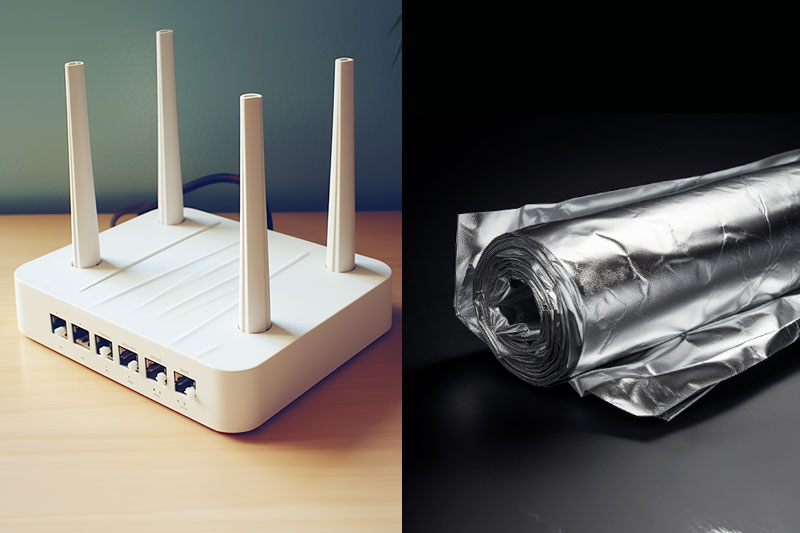
Have you ever wondered how a simple kitchen staple could revolutionize your internet experience? Aluminum foil, that shiny, versatile sheet commonly found wrapped around leftovers, has found its way into the tech world, specifically behind Wi-Fi routers. It might sound like an old wives’ tale, but there’s a growing trend that suggests this household item could be the unsung hero of your home network. But what could possibly link aluminum foil to better Wi-Fi performance?
In our quest for uninterrupted streaming and lightning-fast downloads, we often overlook the simplest solutions. The answer lies in the principles of physics and the design of your living space. When strategically placed, aluminum foil acts as a signal reflector, potentially boosting the strength and reach of your Wi-Fi signal by directing it where it’s needed most. It’s a low-tech hack in a high-tech world, but does it really work, or is it just another internet myth? Let’s unwrap the mystery and see how a bit of foil could make your digital life shine.
A Reflective Solution for Signal Improvement
Ever noticed how your Wi-Fi seems to have a mind of its own, working perfectly in one room but crawling at a snail’s pace in another? You’re not alone. Many households face the challenge of uneven Wi-Fi coverage, leading to frustration and the inevitable search for solutions.
Enter aluminum foil, the unexpected champion of Wi-Fi woes. By reflecting and manipulating the electromagnetic waves emitted by your router, aluminum foil can enhance your network’s performance. Are you skeptical? You should be! After all, it’s essential to question and understand the science behind such claims.
How Does Aluminum Foil Affect Wi-Fi Signals?
Wi-Fi signals are a form of electromagnetic radiation, traveling in waves that can be absorbed, blocked, or reflected by different materials. Aluminum foil, with its metallic properties, is a conductor, which means it can reflect these waves. When placed behind your router, the foil creates a barrier that reshapes the signal’s flow, directing it away from empty spaces and towards areas where connectivity is crucial.
Is It Just a Myth or Science?
It’s easy to dismiss this foil trick as a myth, but there’s a kernel of truth here. Studies suggest that metal reflectors, including aluminum foil, can indeed improve wireless signal strength. For instance, researchers at Dartmouth College developed a 3D-printed reflector with a conductive layer, essentially a sophisticated version of the aluminum foil hack, which showed significant improvements in Wi-Fi signal strength and range.
Maximizing Your Wi-Fi with Household Hacks
So, how do you turn a piece of foil into a tech tool? It’s simpler than you might think. Here’s a step-by-step guide:
- Cut a piece of aluminum foil.
- Fold the edges to create a smooth surface.
- Curve the foil into a parabolic shape.
- Place it behind your router, ensuring it doesn’t touch any of the antenna.
This makeshift reflector can help direct the signal toward your device-heavy areas, like your home office or living room. But remember, results can vary based on your router’s model and your home’s layout.
Real-Life Success Stories
John, a tech enthusiast from Seattle, was struggling with poor Wi-Fi in his basement. After placing aluminum foil behind his router, he saw an immediate boost in signal strength. “It was like night and day,” he says. “I went from buffering videos to streaming HD content without a hiccup.”
But Wait, There’s More…
While the aluminum foil trick may offer a noticeable improvement, it’s not a cure-all solution. Other factors, such as router placement, interference from other devices, and even the construction materials of your home, play significant roles in Wi-Fi performance.
Best Practices for Optimal Wi-Fi
- Position your router in a central location.
- Keep it away from metal objects and appliances that emit electromagnetic waves.
- Update your router’s firmware regularly.
- Consider a mesh network system for larger homes.
Conclusion: Shiny Hacks for the Digital Age
In the end, who would’ve thought that something as mundane as aluminum foil could have a place in the digital age? While it’s not a magic fix, it’s a testament to the power of simple, creative solutions to everyday problems.
Before you go wrapping your router in foil, remember to approach this hack with a mix of curiosity and caution. Experiment with placement and shape, and monitor the results. You might just find that this kitchen staple is the ally your Wi-Fi never knew it needed.
And if you’re still grappling with connection issues, don’t hesitate to seek professional advice. After all, the goal is a seamless online experience, and sometimes, a little expert intervention is just what the Wi-Fi doctor ordered.
Have you tried the aluminum foil trick yet? Share your experiences in the comments below, and let’s continue to demystify the world of home networking together.



